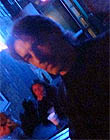|
|
This topic comprises 2 pages: 1 2
|
|
Author
|
Topic: Booking DCP or 35mm
|
|
|
Scott Norwood
Film God

Posts: 8146
From: Boston, MA. USA (1774.21 miles northeast of Dallas)
Registered: Jun 99
|
 posted 03-07-2017 01:45 PM
posted 03-07-2017 01:45 PM





In general, based upon the film programmers that I know and from my experience (which has only involved booking for special events or one-off shows, not a full time cinema), the decision goes like this:
The default choice is normally the original format of the movie, normally 35mm, if prints exist and are available for booking. DCPs of repertory titles are all over the map in terms of quality, so this would be a less desirable option unless a good print is unavailable.
Possible modifiers would include the following:
- a "new, brilliant restoration" of a title where the new version is only available in DCP form (favors DCP)
- audience preference (for some reason, horror-film audiences are attached to 35mm (even battered prints), whereas a kiddie matinee audience probably isn't; could favor 35mm or DCP)
- special guest preference (if someone associated with the picture is present to introduce it and/or give a Q&A, his preference for format usually wins)
- quality of available prints vs. quality of DCP (could favor either)
- venue capabilities (does the venue have a great 35mm system and a marginal D-cinema system or vice versa?)
I am curious to hear others' thoughts on this, but the above seem to be fairly standard, based upon conversations that I have had.
An interesting situation arises if the title in question is unavailable on both 35mm and DCP. Some people are open to showing a home format (Blu-Ray, DVD, etc.) and some would prefer 16mm. I feel pretty strongly against the showing of consumer formats in cinemas, but 16mm of a movie originally shot and shown in 35mm is almost universally a disappointing experience. My own inclination in such a case would be to book a different title and berate the distributor, but most would probably take the consumer video option.
| IP: Logged
|
|
Mitchell Dvoskin
Phenomenal Film Handler

Posts: 1869
From: West Milford, NJ, USA
Registered: Jan 2001
|
 posted 03-07-2017 01:57 PM
posted 03-07-2017 01:57 PM




I tend to agree with what Scott says.
For classic films, if the theatre has good presentation in 35mm and still has qualified projectionist, and a good quality print can be obtained, I would go with 35mm. If not, DCP.
It is not so much that some people prefer 35mm as it is that some people prefer to see a film in it's original media format. They feel they can watch video at home, they go out to see a film as it was originally shown.
Where I disagree with Scott is that I would run Bluray over 16mm every time. With rare exceptions, sharper picture, correct aspect ratio, and better sound than 16mm.
| IP: Logged
|
|
|
|
|
|
|
|
Leo Enticknap
Film God

Posts: 7474
From: Loma Linda, CA
Registered: Jul 2000
|
 posted 03-08-2017 02:27 PM
posted 03-08-2017 02:27 PM





quote: Scott Norwood
- quality of available prints vs. quality of DCP (could favor either)
I'd expand that to "quality of all available elements," e.g. 70mm, 35mm, 16mm, DCP, BD, and sometimes broadcast standard VT formats as well.
This is one of the reasons why we keep extensive screening and media condition reports for all our shows. I have gotten complaints from some of my co-workers that I'm asking them to record too much information, some of it unnecessary, in response to which I explain that the reports serve three functions.
1 - To enable us to respond effectively to any accusations that we damaged a print made after it ships out, by recording in detail its condition when it entered the building.
2 - To save time when preparing the same film print, DCP or other medium for a repeat screening (for example, by noting the timecode of an intermission card in a DCP of a roadshow feature)
3 - To enable the programmers to make an informed decision as to which to play on a repeat show of the same title, in cases where there are different choices available.
In 2 alone, I reckon that our reporting system has achieved a net saving in projectionist time. It certainly has for mine. It has also saved us a $20k print replacement bill in the case of 1. There is one large and well known nonprofit archive that shall remain nameless, and that I get the strong impression only inspects its prints after every 3-4 bookings. The accused us of having chopped the heads and tails off, and plattered, a nearly new print of a recent restoration, in response to which I was able to produce our report stating that the print was received in that state. Further investigation revealed that the print had crossed over straight to us from another venue, and it was they that had cut it up.
| IP: Logged
|
|
|
|
Leo Enticknap
Film God

Posts: 7474
From: Loma Linda, CA
Registered: Jul 2000
|
 posted 03-09-2017 09:13 AM
posted 03-09-2017 09:13 AM





We have a show coming up on Saturday (a French movie from the 1950s), for which the choice is a BD, importing a 35mm print from France, showing a movie in French without subtitles, or not showing it at all. There is no English subtitled DCP available. The BD is about as good as a BD is going to get (aspect ratio correct, nice transfer from a low contrast element, audio correctly mastered as mono on the center channel, high bitrate, etc. etc.), we can't afford to import the print, and playing the movie unsubtitled would draw a huge number of complaints from customers who'd failed to read the website properly and showed up expecting subtitles. So it's an effective choice between the BD and not showing this title.
Would you choose not to show this title in this situation? There are some venues that would make that choice. We've decided that with full disclosure (our website states clearly that the screening source is a BD, and we feel more comfortable defending that than no subtitles if it comes to customer complaints), the cultural argument (this is part of a series co-curated by a programming partner, and she really wants that movie to play in a specific double feature with another title) overrides the technical quality one.
We have once shown an unsubtitled movie, but this was as part of an Argentinian festival, it was in Spanish, and there are a large number of Spanish speakers in LA. This was an emergency (DCP drive arrived bad on the day of the show, and an unsubtitled DVD was the only alternative that could be got to our booth in time): a manager went up on stage at the start and offered refunds and comps to anyone who objected either to seeing a DVD or who needed the subtitles. Out of an audience of about 100, two did so. But we'd never get away with that for a movie in French.
| IP: Logged
|
|
|
|
|
|
Jim Cassedy
Phenomenal Film Handler

Posts: 1661
From: San Francisco, CA
Registered: Dec 2006
|
 posted 03-09-2017 01:07 PM
posted 03-09-2017 01:07 PM




quote: Steve Guttag
Some 16mm scope movies can look surprisingly good
Some time back in the mid 1970's I ran a 16mm scope print of
"The Towering Inferno" for a bunch of officers at either Ft
Meade MD, or Ft Belvoir, VA (both not far from you, Steve)
It was a new, lab fresh, 16mm print I was running for review
by the AAFMPS. (Army/Air Force Motion Picture Services)
It was a large screening room. I don't remember the size of
the screen, but it was at least as large as The Army had at
some if its' smaller military base theaters.
I expected an image that "looked like 16mm", but I was, and
still am, amazed at how good it looked on that screen, especially
since I had just run a 35mm print of it several days before on a
screen not much larger than the one in that screening room. If I
had walked into that 16mm screening, I think I might not have
noticed for some time, and perhaps not at all, that I was watching
a 16mm print.
Of course I was working under 'ideal' conditions, with a new print,
and a projection system that was kept in tip-top shape since this
screening room was primarily used for screenings by military big-wigs,
and for evaluating 16 & 35mm prints of military films for the AAMPS.
Projection equipment was was a pair of military B&H JAN projectors,
equipped with change-overs and either a small xenon or a GE MARC
300 light source, which were popular at that time.
(I can't remember which- - but it definitely wasn't incandescent)
16mm sound was EQ'd through some custom ALTEC filter box, and
then sent to the standard house 35mm sound amps.(Also Altec)
In fact, one of the reasons I did that screening was that the military
was at that time considering closing some of their 35mm base theaters,
which were becoming too expensive to operate, and replacing them with
hi-quality 16mm systems & prints.
Quite frankly, they had been doing this on a limited scale since WWII,
but they were thinking of expanding this method of operation to many
more bases, and so they were doing a number of test screenings to
evaluate the quality of the 16mm prints and projection process.
| IP: Logged
|
|
|
|
Scott Norwood
Film God

Posts: 8146
From: Boston, MA. USA (1774.21 miles northeast of Dallas)
Registered: Jun 99
|
 posted 03-09-2017 02:14 PM
posted 03-09-2017 02:14 PM





Leo--I agree that your example is a difficult situation. For me, the decision of what to do would depend somewhat on the purpose of the screening.
If the intention is to show something (anything) that will sell tickets and entertain the audience, then I would probably just pick a different title. Plenty of good movies have been made over the last 100 years, and many of them are available in their original formats.
If the intention is to show that particular title because audiences are clamoring for it and it has not screened anywhere in the area ever or for many years, then I think that a good argument can be made for screening the subtitled Blu-Ray, especially if the quality of it is good and if the budget is low enough that the screening could not happen if a print had to be shipped. At least you are being truthful to the audience and they can decide whether or not this screening is worth the ticket price. Others may disagree, but my personal opinion is that un-subtitled prints/DCPs are usually a sub-optimal viewing experience, unless the entire audience speaks the language used in the film.
Part of the problem here is that it can sometimes be difficult to evaluate the relative merits of the available prints vs. other formats without actually booking both. At least Leo's venue is on the west coast of the US, where most of these prints are now stored. It can be pretty heartbreaking when a crappy print gets shipped to a venue here on the east coast at great expense (roughly $100 each way for a normal-length 35mm print in Goldberg cans). It would help if prints were inspected after each booking and the reports were made available to venues that want to book them, but that seems unlikely to happen any time soon.
| IP: Logged
|
|
|
|
|
|
All times are Central (GMT -6:00)
|
This topic comprises 2 pages: 1 2
|
Powered by Infopop Corporation
UBB.classicTM
6.3.1.2
The Film-Tech Forums are designed for various members related to the cinema industry to express their opinions, viewpoints and testimonials on various products, services and events based upon speculation, personal knowledge and factual information through use, therefore all views represented here allow no liability upon the publishers of this web site and the owners of said views assume no liability for any ill will resulting from these postings. The posts made here are for educational as well as entertainment purposes and as such anyone viewing this portion of the website must accept these views as statements of the author of that opinion
and agrees to release the authors from any and all liability.
|

 Home
Home
 Products
Products
 Store
Store
 Forum
Forum
 Warehouse
Warehouse
 Contact Us
Contact Us




 Printer-friendly view of this topic
Printer-friendly view of this topic









![[Frown]](frown.gif)








